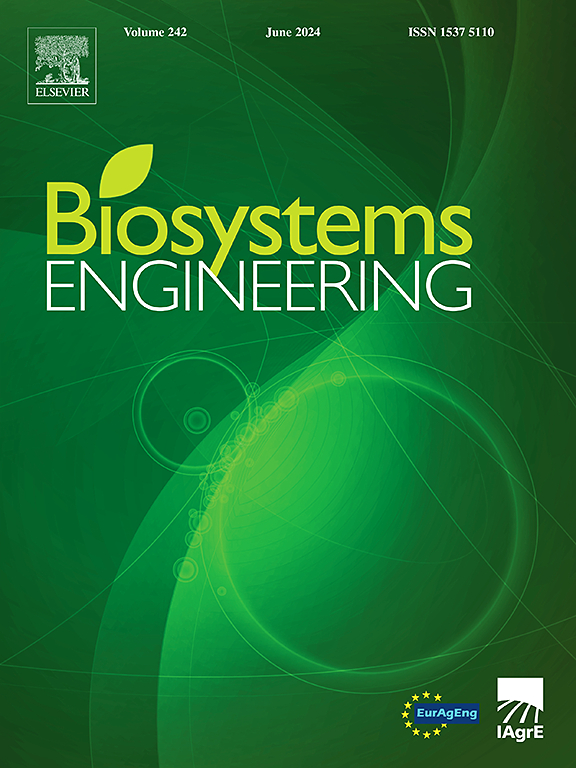Re-identification for long-term tracking and management of health and welfare challenges in pigs
IF 5.3
1区 农林科学
Q1 AGRICULTURAL ENGINEERING
引用次数: 0
Abstract
The fine-grained management of farm animals using video analytics relies on long-term visual tracking of individual animals. When an individual is occluded or exits the camera's field of view, tracking can be lost. The problem of using visual features to re-assign identity after loss of tracking is known as re-identification. In the case of pigs, this problem is especially challenging due to the similar appearances of most individual animals within a pen.
To address this issue, an image-based pig re-identification method is developed that is invariant to pose, illumination, and camera viewpoint. This method allows pigs to be reidentified, enabling long-term monitoring. This approach uses a Vision-Transformer model (ViT) previously developed for person re-identification. The model was trained using specifically designed pig re-identification datasets with a diverse range of housing and management conditions. These datasets use overhead cameras, allowing an investigation of the effect of the detection approach on re-identification performance. Re-identification using a traditional axis-aligned pig detector was compared with a recently developed oriented pig detector that better matches the pig's pose when extracting the pig from the wider image. It was found that the use of an oriented detector led to improved performance. The proposed system achieved a peak rank-1 Cumulative Matching Characteristic (CMC) performance of 90.5%. Furthermore, it is shown that this model is capable of generalising across different farms, achieving an average rank-1 CMC 81.8% in the cross-farm setting. Finally, the proposed re-identification features can be incorporated into an existing multi-object tracking system to improve its performance at reacquiring pig identities when tracking is lost. Overall, this work demonstrates the potential of using visual re-identification features of pigs to enable individual-level animal management.

重新识别长期跟踪和管理猪的健康和福利挑战
使用视频分析对农场动物进行细粒度管理依赖于对单个动物的长期视觉跟踪。当一个人被遮挡或退出相机的视野时,跟踪可能会丢失。在失去跟踪后,利用视觉特征重新分配身份的问题被称为重新识别。在猪的情况下,这个问题尤其具有挑战性,因为大多数动物在一个围栏内的个体外观相似。为了解决这一问题,研究人员开发了一种基于图像的猪的再识别方法,该方法对姿态、光照和摄像机视点都是不变的。这种方法可以重新识别猪,实现长期监测。这种方法使用了先前为人员再识别开发的视觉转换模型(ViT)。该模型使用专门设计的猪再识别数据集进行训练,这些数据集具有不同的饲养和管理条件。这些数据集使用头顶摄像机,允许调查检测方法对重新识别性能的影响。将传统的轴向猪检测器与最近开发的定向猪检测器进行了比较,后者在从更宽的图像中提取猪时能更好地匹配猪的姿势。结果发现,定向探测器的使用提高了性能。该系统的峰值阶累积匹配特性(CMC)性能达到90.5%。此外,研究表明,该模型能够推广到不同的农场,在跨农场设置中实现平均排名1的CMC 81.8%。最后,所提出的重新识别特征可以整合到现有的多目标跟踪系统中,以提高其在丢失跟踪时重新获取猪身份的性能。总的来说,这项工作证明了利用猪的视觉再识别特征来实现个体水平动物管理的潜力。
本文章由计算机程序翻译,如有差异,请以英文原文为准。
求助全文
约1分钟内获得全文
求助全文
来源期刊

Biosystems Engineering
农林科学-农业工程
CiteScore
10.60
自引率
7.80%
发文量
239
审稿时长
53 days
期刊介绍:
Biosystems Engineering publishes research in engineering and the physical sciences that represent advances in understanding or modelling of the performance of biological systems for sustainable developments in land use and the environment, agriculture and amenity, bioproduction processes and the food chain. The subject matter of the journal reflects the wide range and interdisciplinary nature of research in engineering for biological systems.
 求助内容:
求助内容: 应助结果提醒方式:
应助结果提醒方式:


